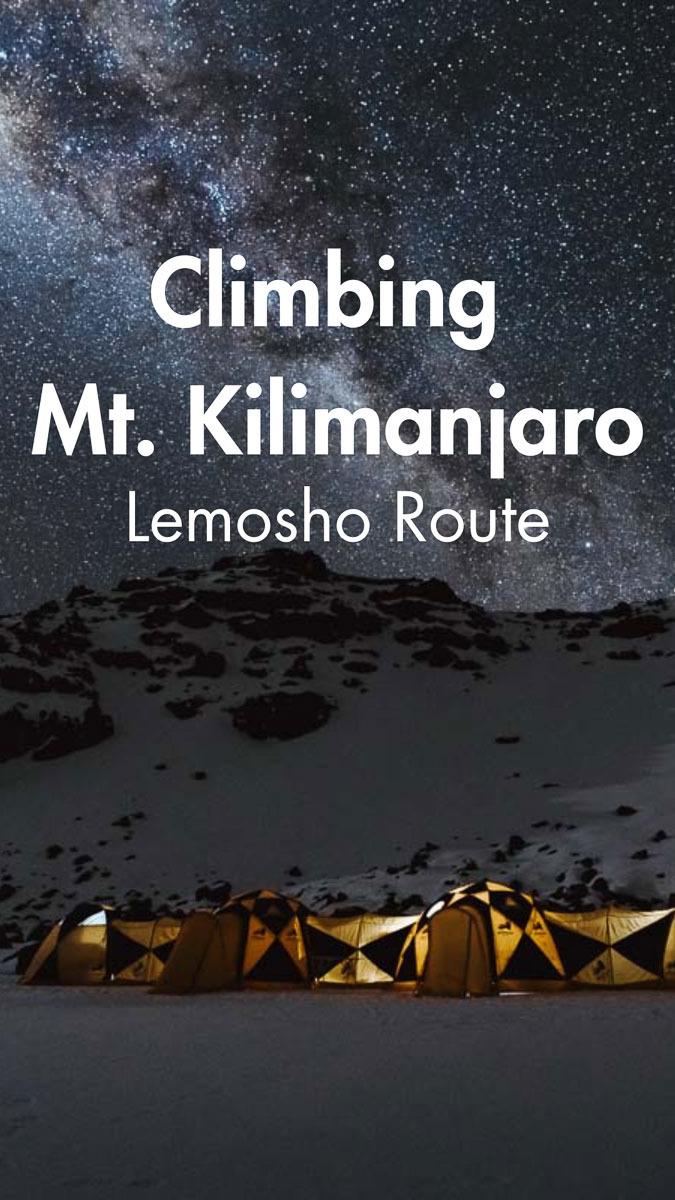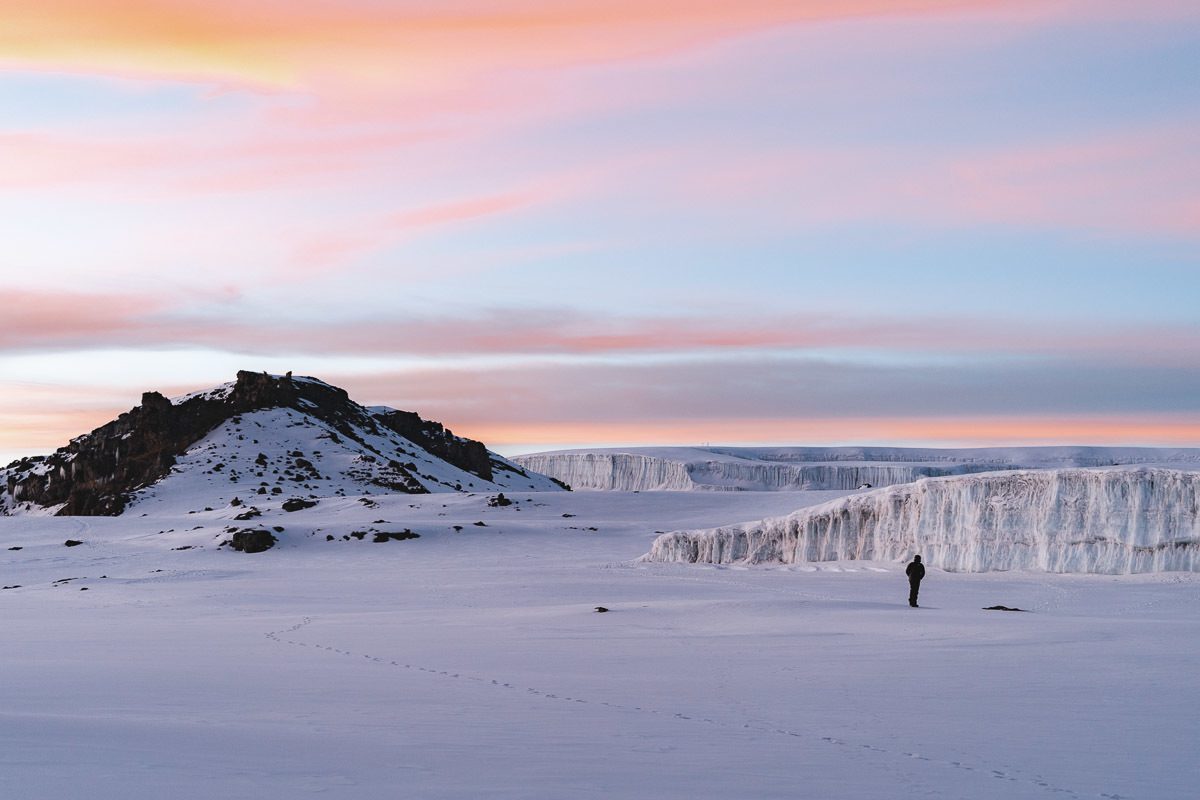Some of our links are affiliated, we will earn a commission when you buy a service or product. This will have no extra cost for you. For further info please refer to our Privacy Policy
Is conquering Mount Kilimanjaro’s Lemosho Route in your adventure plans? Then you are in the right place!
Welcome to the awe-inspiring world of Mt. Kilimanjaro, the highest peak in Africa and one of the world’s most sought-after trekking destinations.
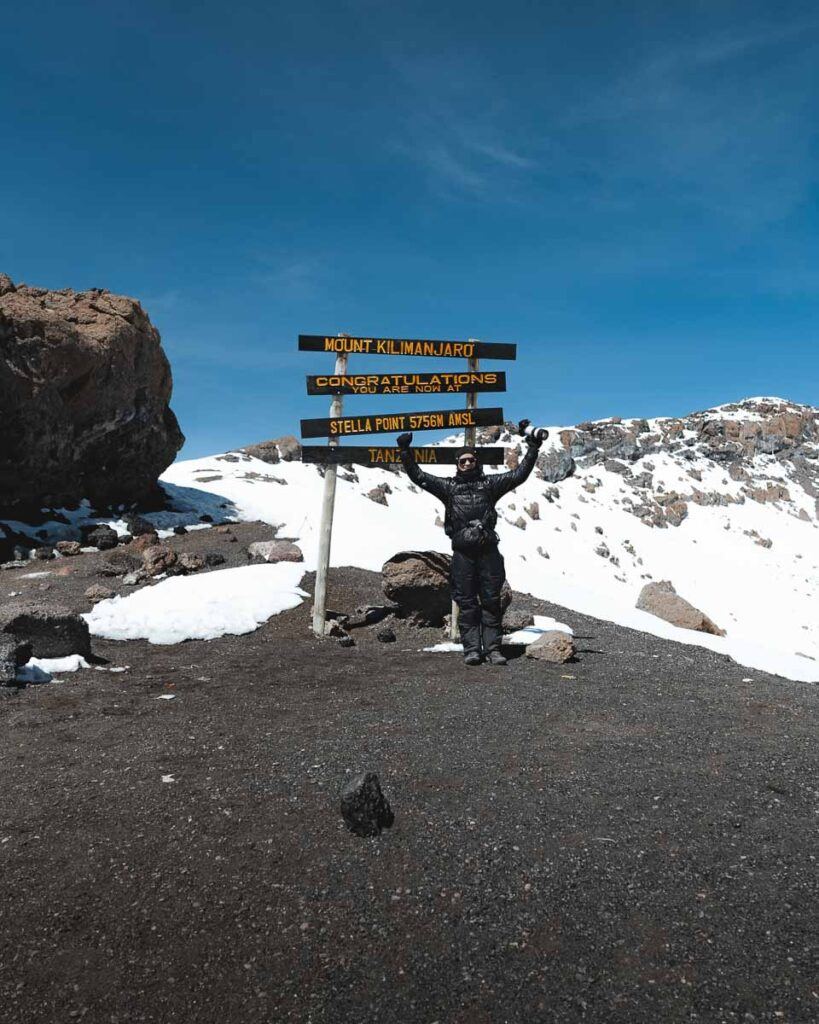
Located in northeastern Tanzania, this mountain stands tall at a staggering 5,895 meters (19,341 feet) above sea level, offering a thrilling challenge for adventure seekers.
Mount Kilimanjaro boasts a variety of climbing routes, each with its unique features and difficulties. Among these routes, the Lemosho Route has gained popularity for its stunning scenery, gradual acclimatization, and high summit success rates.
Trekking up Mount Kilimanjaro is not for the faint of heart, but with the right preparation and mindset, it can be an adventure of a lifetime.
In this Lemosho Route Kilimanjaro Guide, we will delve into the details of the route, highlighting its key features, trekking facts, and practical tips to ensure a successful and enjoyable journey.
So, lace up your boots, pack your essentials, and get ready to embark on an unforgettable adventure on Mount Kilimanjaro’s Lemosho Route!
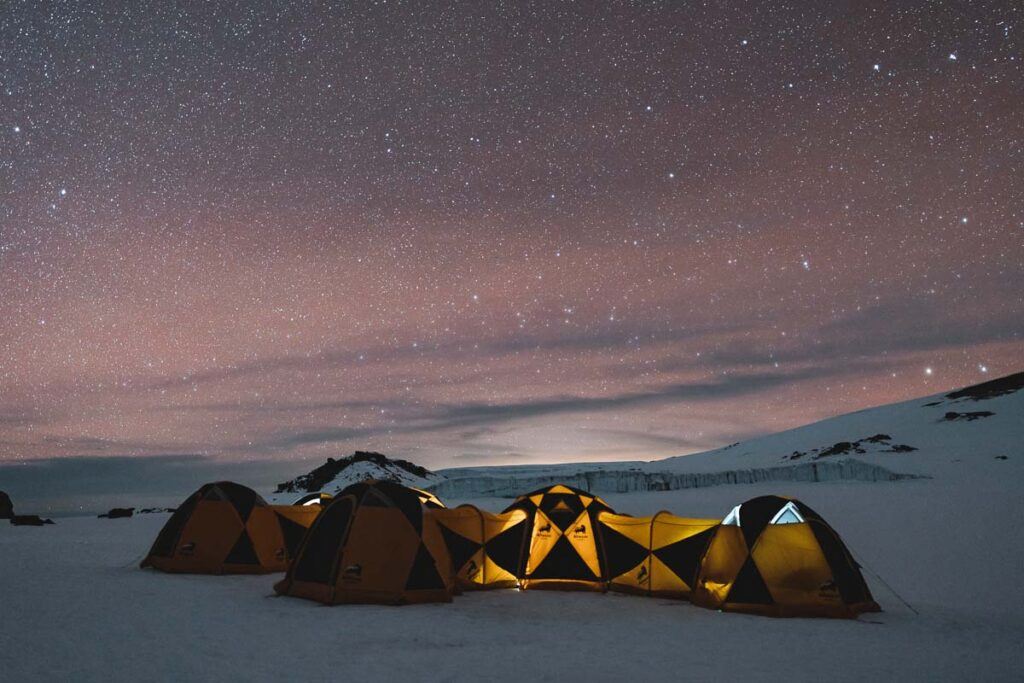
What is the Mount Kilimanjaro Lemosho Route?
The Lemosho Route is one of the seven routes you can climb to submit to Mount Kilimanjaro.
The Lemosho Route Kilimanjaro offers hikers a stunning accent to the iconic Uhuru Peak. This route provides an immersive and breathtaking experience with diverse ecosystems, from lush rainforests to alpine deserts.
Where is the Lemosho Route located?
The Lemosho Route Kilimanjaro is one of the most scenic and less crowded routes. The starting point of the Lemosho Route is at the Londorossi Gate, situated on the Western side of the mountain.
To reach the gateway of this route, you can fly into the Kilimanjaro International Airport, the closest airport to the mountain. From the airport, it is approximately a 2-hour drive to reach the Londorossi Gate.
Alternatively, if you are already in Tanzania, you can also travel to the Lemosho Route by road. The drive from popular tourist destinations like Arusha or Moshi to the Londorossi Gate takes around 3-4 hours.
Once you arrive at the gate, you will go through the necessary registration and permit procedures before starting your trek on the Lemosho Route.
It is advisable to hire an experienced guide and porters to assist you throughout the journey, ensuring your safety and comfort every step of the way. More about these details later on.
How long is the Kilimanjaro Lemosho Route?
It’s one of the longer routes, spanning approximately 70 kilometers (43 miles).
The Lemosho Route provides a longer and more gradual ascent, giving climbers a better chance to adjust to the altitude, reduce the risk of altitude sickness, and increase their chances of reaching the iconic Uhuru Peak.
How many days do you need to climb the Lemosho Route?

The standard itinerary for the Lemosho Route usually takes 8 to 9 days to complete, including time for an acclimatization hike. However, there are also optional itineraries that allow you to complete the trek in 6 or 7 days.
Choosing to climb the Lemosho Route in 6 days is a more challenging option and is generally recommended for experienced hikers who are already acclimatized to high altitudes. This itinerary involves longer and more strenuous days of hiking, with less time for acclimatization.
It is important to note that attempting to summit Kilimanjaro in such a short timeframe significantly increases the risk of altitude sickness and reduces the chances of reaching the summit successfully.
On the other hand, opting for the 7-day itinerary provides a slightly more relaxed pace and an extra day for acclimatization.
The standard 8-day itinerary is the most recommended option for most climbers. This itinerary includes shorter hiking days, allowing climbers to gradually adjust to the altitude and enjoy the stunning views along the way.
The 8-day Lemosho Route itinerary idea:
- Day 1 – Trekking from Londorossi Gate to MTI Mkubwa Camp (2 Km / 1h)
- Day 2 – Trekking from Mti Mkubwa Camp to Shira 1 Camp (5km / 6h)
- Day 3 – Trekking from Shira Camp 1 to Shira Camp 2 (2km / 2h)
- Day 4 – Trekking from Shira 2 Camp to Lava Tower finishing at Barranco Camp (12km / 6-8 hours)
- Day 5 – Trekking from Barranco Camp to Karanga Camp (2.5km / 2h)
- Day 6 – Trekking from Karanga Camp to Barafu Camp (2km / 2h). This day, you will have an acclimatization climb to Kosovo Camp (2km / 1-2 hours).
- Day 7 – Trekking to Uhuru Peak followed by the descent to Millennium Camp (15km / 8-12 hours).
- Day 8 – Descent from Millennium Camp to Mweka Gate (12km / 4-5 hours).
The 7 or 6-day route will skip a few stops and will add a couple of hours to the trekking time.
On top of the trekking days, you must add at least two more days for your arrival and departure.
Ultimately, the decision on how many days to climb the Lemosho Route depends on your physical fitness level, previous acclimatization/trekking experiences, and personal preferences.
It is important to choose an itinerary that suits your abilities and gives you the best chance of a successful and memorable hiking adventure. Need more inspiration? Read this incredible story about climbing the Kilimanjaro Lemosho Route.
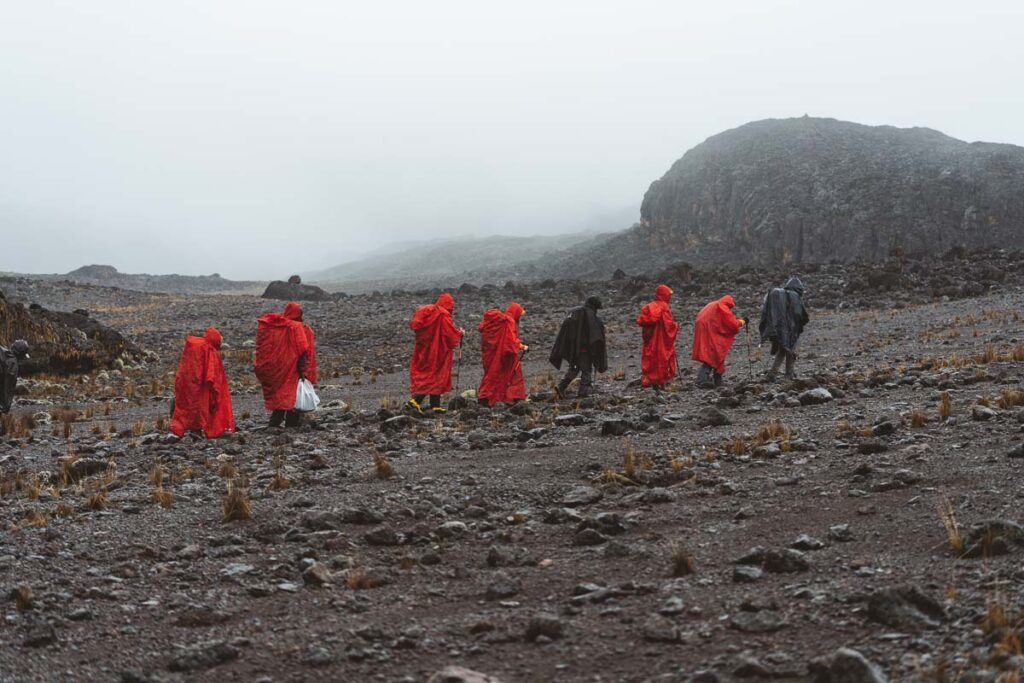
Lemosho Route Difficulty Level
The Lemosho Route is considered a moderately difficult route to climb Mount Kilimanjaro. However, with proper preparation, training, and the guidance of experienced guides, climbers can successfully conquer the Lemosho Route and reach the summit of Africa’s highest peak.
How difficult is it to climb the Lemosho Route Kilimanjaro?
Lemosho is a longer route that allows for better acclimatization and increases the chances of reaching the summit. But on the other hand, the distance and its steep and rough terrain can challenge the hikers.
The trail involves trekking through various landscapes, including rainforest, alpine desert, and rocky terrain. Climbers will encounter steep ascents and descents, as well as tricky sections such as the Barranco Wall.
Altitude sickness is also a potential difficulty when ascending to high altitudes quickly. It is crucial to take proper precautions and allow enough time for acclimatization.
Additionally, the weather on Mount Kilimanjaro can be unpredictable, and climbers may encounter cold temperatures, rain, and even snow. Proper gear and clothing are essential to tackle the challenging conditions the bad weather brings.
Overall, climbing the Lemosho route requires physical fitness, mental determination, and proper preparation.
Hiring experienced guides and ensuring proper training and acclimatization are crucial for a successful summit attempt.
Lemosho Route Success Rate
The Lemosho route is known for its impressive success rates that range from 80% to 90%, depending on how many days the climb is.
Factors that result in success climbing rate:
- Time for acclimatization, helping climbers further adjust to the altitude.
- Experienced and trained guides familiar with the route and its challenges.
- Daily medical check-ups.
- Quality food during the climb.
- Quality gear and camping equipment.
- The Lemosho Route provides stunning views and a varied landscape, making the journey more enjoyable and motivating for climbers.
- Climbers’ preparation and knowledge about the Kilimanjaro National Park and its routes are also fundamental.
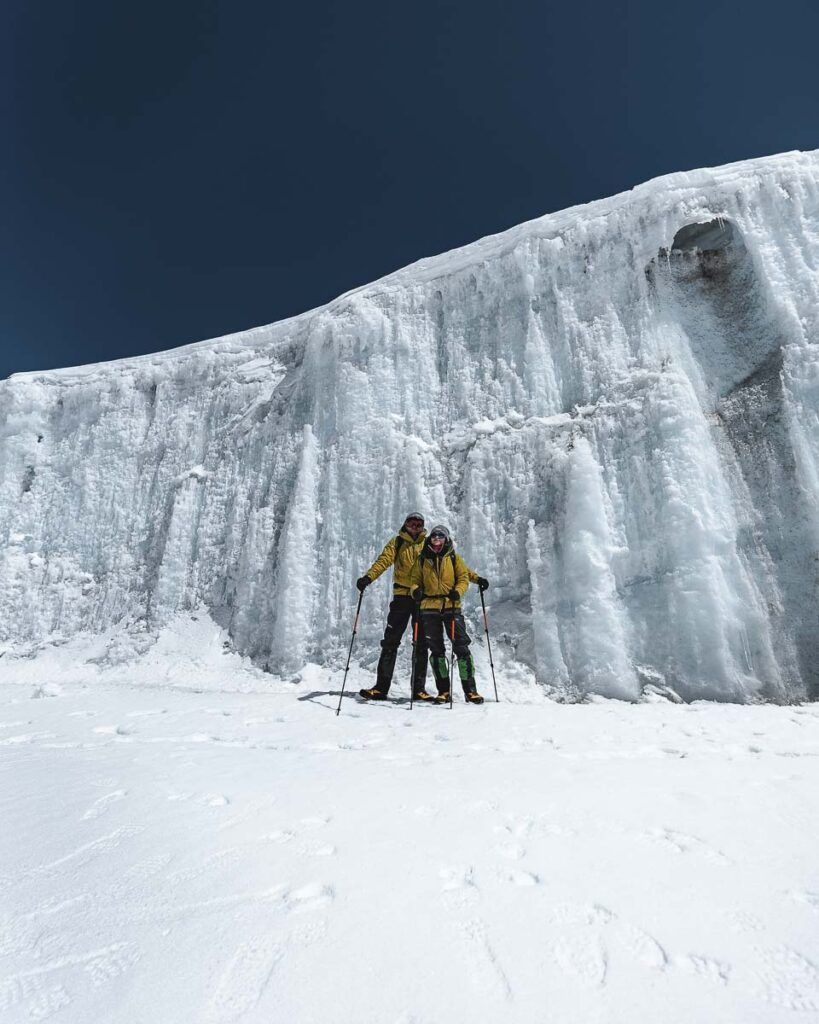
How physically prepared do you need to be to climb the Lemosho Route?
The physical preparation required for the Lemosho route on Mount Kilimanjaro cannot be overstated.
“Climbing Kilimanjaro via the Lemosho Route is not just about endurance, but also about how well your body can adapt to altitude,” asserts Marvin Derichs, a mountain expert from Altezza Travel.
Marvin asserts that while the trek is not a technical climb, it does demand a certain level of physical fitness and readiness. You need to be in good shape and have reasonable stamina to enjoy the climb and increase the chances of reaching the summit.
Marvin recommends that if you haven’t been very physically active, you should start getting in shape at least two months before your trek. But if you already exercise regularly, a month of specific training should be enough.
“Try to do cardio exercises like biking, swimming, or running to strengthen your heart and lungs,” he suggests. “If you can, it’s best to hike in areas with hills to get used to the type of terrain you’ll come across on the Lemosho route.
“He also advises doing some strength exercises that focus on your legs and core muscles. Marvin highlights that not only physical training but also mental readiness is important, as it plays a big part in the trip.
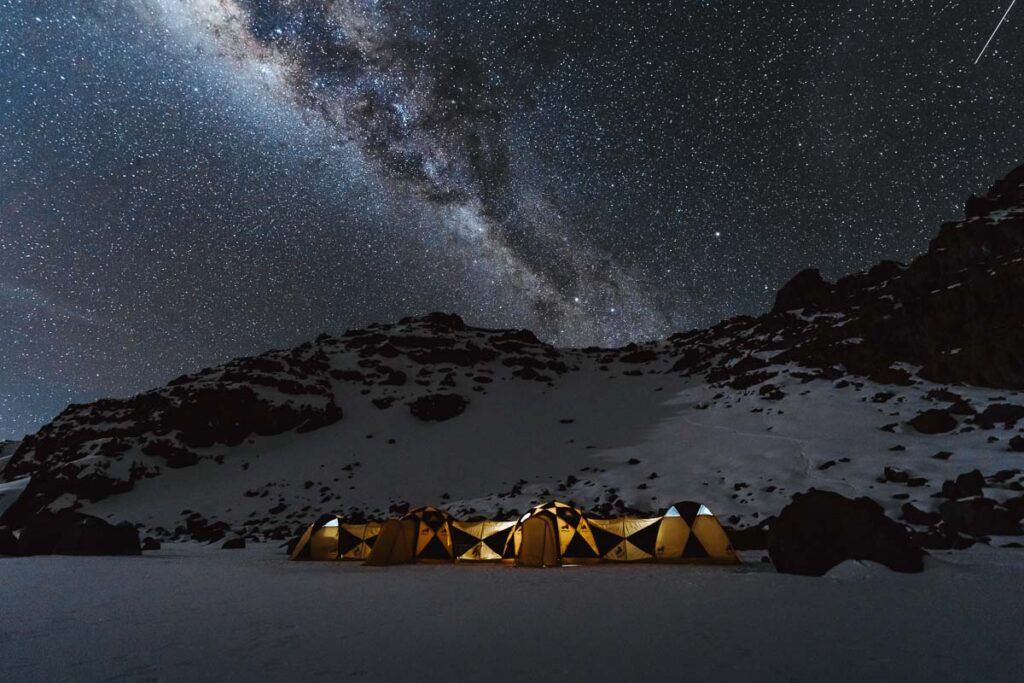
Highlights of the Mt Kilimanjaro Lemosho Route
The Lemosho Route is known for its stunning natural beauty and breathtaking views.
As you make your way up the mountain, you will be treated to panoramic vistas of lush rainforests, alpine meadows, and rugged terrain.
The route also offers an unmatched opportunity to experience the local culture and interact with the warm and friendly people of Tanzania.
One of the highlights of the Lemosho Route is reaching Barranco Camp, located at an altitude of approximately 3,900 meters (12,800 feet). As you ascend the Barranco Wall, you will be rewarded with awe-inspiring views of the surrounding landscape.
Another standout feature of the Lemosho Route is the Lava Tower, a volcanic formation over 4,500 meters (14,764 feet) above sea level. This geological wonder offers a unique backdrop for rest and provides an excellent opportunity to take in the surrounding scenery.
As you continue your journey, after the Barafu Camp, you will come across the alpine desert, a barren landscape that seems to stretch on forever. Although devoid of vegetation, the alpine desert is an awe-inspiring sight, with its vast expanse of rocky terrain and distant mountain peaks.
One of the best moments of the Lemosho Route is, of course, the summit push. As you make your final ascent to Uhuru Peak (5,895m / 19,341 feet) the highest point on Mount Kilimanjaro, the sense of anticipation and excitement is incredible.
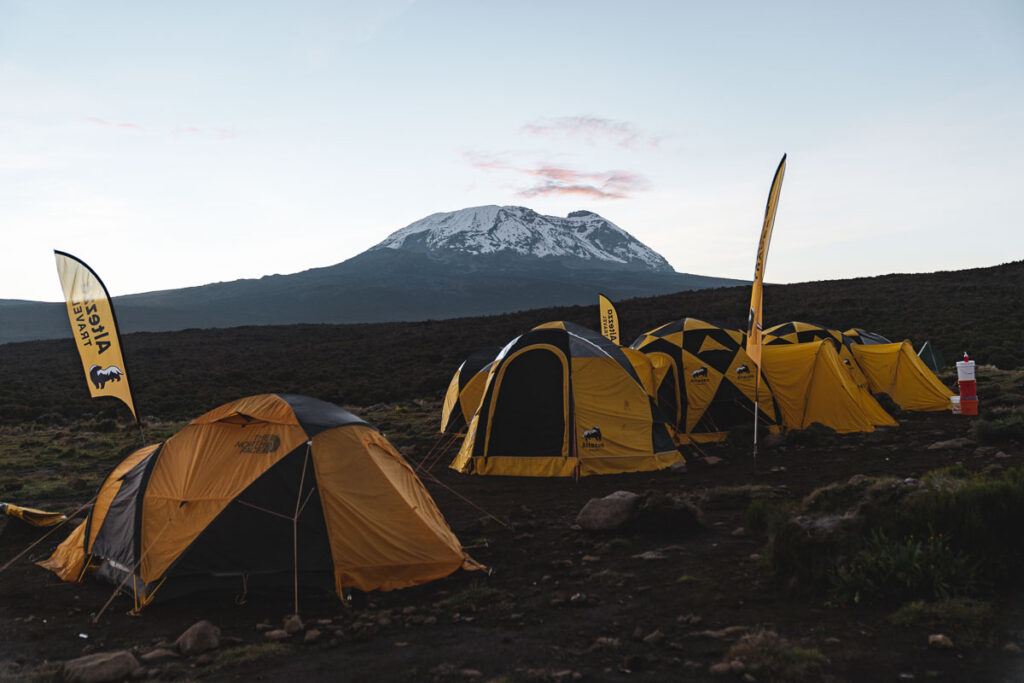
Planning Your Trip Mount Kilimanjaro
Planning is crucial to ensure a safe and successful climbing on Mount Kilimanjaro.
Before embarking on your Kilimanjaro adventure, do thorough research and consider important factors such as your fitness level, choosing the right tour operator, weather conditions, gear requirements, and what to pack for your adventure.
It is also recommended to book your climb well in advance, especially during peak seasons, to secure your spot and allow time for your physical and mental preparations.
The best time to climb Mt Kilimanjaro
The best time to climb Mt Kilimanjaro via the Lemosho Route is during the dry seasons, which are typically from June to October and from December to February.
These periods offer the most comfortable temperatures and the least amount of precipitation.
During the dry seasons, the weather on Mount Kilimanjaro is generally cool and dry, making for better climbing conditions. However, it’s important to note that temperatures can still drop significantly, especially at higher altitudes.
The average temperature at the base of Mt Kilimanjaro is between 21ºC – 27ºC (70 to 80 Fahrenheit). As you climb up, the temperatures go down, and it can get as cold as -7ºC to -29ºC (-20ºF) during the night.
It’s crucial to be prepared for a wide range of temperatures and to pack accordingly.
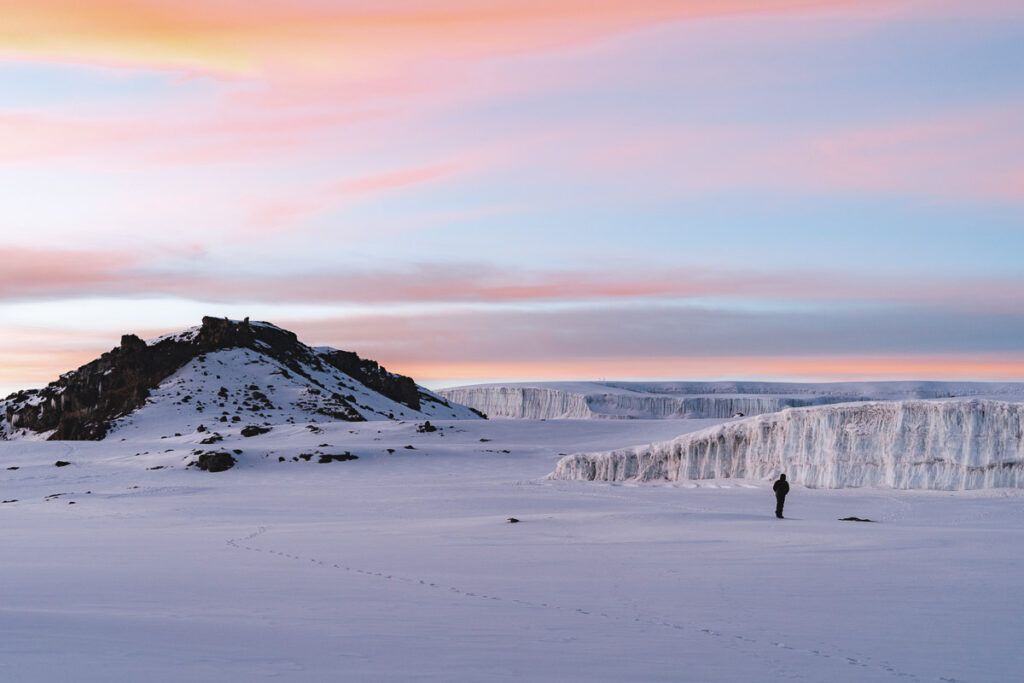
Here are the weather conditions on Mount Kilimanjaro throughout the year:
- January: It is relatively dry, with occasional showers.
- February: Similar to January, it is relatively dry, with occasional showers.
- March: It is the beginning of the rainy season, so rainfall increases.
- April: It is the peak of the rainy season, with increased rainfall.
- May: It is still the rainy season with occasional showers.
- June: It is the start of the dry season, with decreasing rainfall.
- July: It is the dry season with minimal rainfall.
- August: Dry season continues with minimal rainfall.
- September: Dry season continues, with the weather starting to warm up.
- October: It is towards the end of the dry season, with warmer temperatures.
- November: It is the start of the short rainy season.
- December: It is the beginning of the short dry season, with decreasing rainfall.
It’s worth noting that weather conditions can vary, and it’s always a good idea to check the forecast closer to your climb date.
Choosing a Mt. Kilimanjaro Tour Operator
When planning to climb the Lemosho Route on Mount Kilimanjaro, one of the most important decisions you have to make is choosing a tour operator.
A reliable and experienced tour operator can greatly enhance your climbing experience and ensure your safety throughout the journey.
First and foremost, it’s crucial to select a tour operator that is licensed and registered with the Tanzanian government. This ensures they meet safety standards and have professional guides and the necessary permits to operate on the mountain.
Additionally, look for operators affiliated with reputable climbing associations or organizations.
Experience is key. Look for companies that have been organizing climbs on the Lemosho Route for several years. They will have a deep understanding of the route, weather conditions, and potential challenges, making them better equipped to handle any situation that may arise.
Consider the size of the groups that the tour operator typically leads. Smaller groups allow for more individual attention from guides, ensuring a safer and more personalized experience.
Read reviews and testimonials from previous climbers to get a sense of the tour operator’s reputation. Pay attention to feedback regarding the quality of guides, equipment provided, and overall customer satisfaction.
Lastly, consider the cost and value offered by the tour operator. While it’s important to find a competitive price, remember that cheaper doesn’t always mean better. And don’t forget to check if the price includes the park fees.
Look for operators that provide high-quality equipment, well-trained guides, fully loaded medical kits, oxygen bottles, and comprehensive services like transportation, accommodations, and breakfast/lunch/dinner meals.
Also, check if they support the local community, and if it’s a tour operator that aims for a responsible adventure protecting Mt Kilimanjaro.
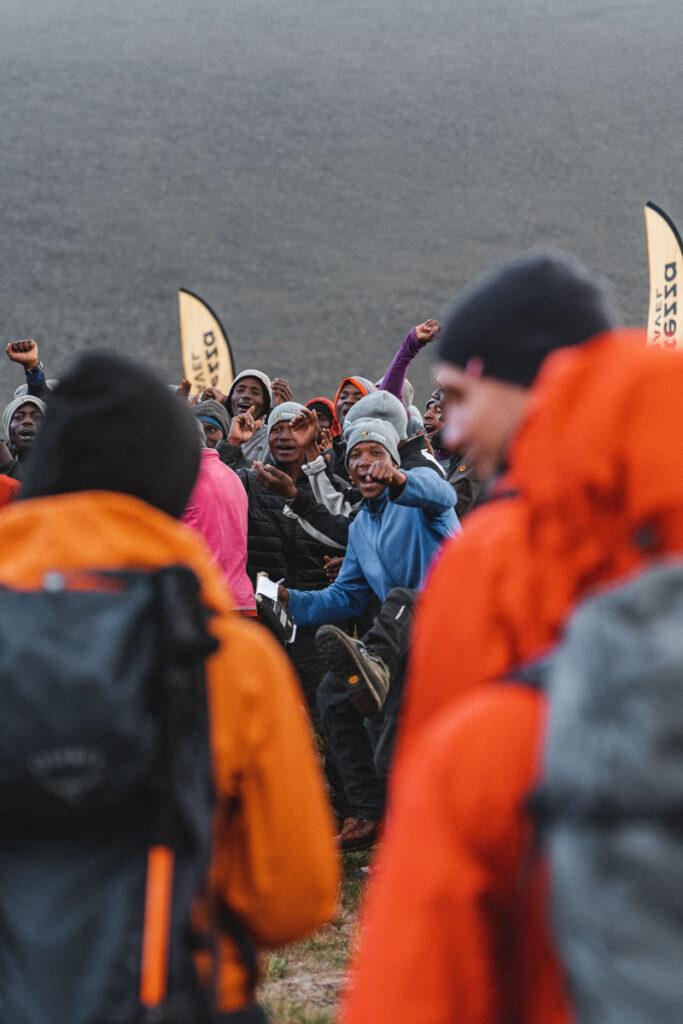
Kilimanjaro Packing List and Preparation
Packing the right gear is essential for a comfortable and safe climb. Invest in quality clothing, layers to adapt to changing temperatures, sturdy hiking boots, and a reliable backpack.
Here are a few things you need to add to your packing list. Some of them you will need to buy and pack for yourself, others will be offered by the Kilimanjaro tour operator, so you know what to look for when booking.
| Clothing: Moisture-wicking base layers Insulating layers (fleece or down jacket) Waterproof and windproof outer shell Hiking/trekking pants and shorts Thermal socks and hiking boots Hat, gloves, and buff Sunglasses and sunscreen |
Equipment: Backpack (around 50-70 liters) Trekking poles Headlamp and extra batteries Water bottles or hydration bladder Snacks, energy bars, and electrolyte tablets Personal medications Portable charger for electronic devices Duct tape and a multi-tool |
| Sleeping Gear: Sleeping bag (rated for sub-zero temperatures) Sleeping pad or mattress |
Accessories: Camera or smartphone for capturing stunning views Dry bags or waterproof covers for protecting your gear Wet wipes and hand sanitizer for personal hygiene Personal toiletries and toilet paper Extra plastic bags for storing dirty laundry |
Packing and Gear Preparation:
- Test and break in all your gear before the climb to ensure they fit well and are comfortable.
- Pack your backpack strategically, keeping frequently used items easily accessible.
- Pack light and only bring essential items to reduce the weight on your back.
Pros and Cons of Climbing the Lemosho Route
If you are still not sure if the Lemosho Route is the best option for you to conquer Mount Kilimanjaro summit, here is a pros and cons summary that might help.

Pros:
– Scenic Beauty: The Lemosho Route offers stunning views of the untouched wilderness terrain, traversing various ecological zones, from lush rainforest to alpine desert. It is known for its spectacular scenery, making the climb a memorable experience.
– High Success Rates: The Lemosho Route has higher success rates compared to other routes due to its longer duration and better acclimatization.
– Less Crowded: The Lemosho Route is less crowded than other popular routes like the Machame or Marangu routes. Which provides a more serene and peaceful climbing experience with fewer hikers on the trail.
– Better for Acclimatization: The longer duration and gradual ascent of this route allows for better acclimatization to the high altitude reducing the risk of altitude sickness.
Cons:
– Longer Duration: The Lemosho Route is one of the longest routes on Kilimanjaro, typically taking 7-8 days to complete, which requires more time commitment and can be a disadvantage for climbers who have limited vacation days.
– Higher Cost: Due to the longer duration and the need for additional permits, this Lemosho can be more expensive than other routes. It is important to budget accordingly and consider the additional costs involved.
– Challenging Terrain: The Lemosho Route includes some sections with challenging terrain, such as the Barranco Wall. Climbers need to be prepared for steep ascents and descents, as well as the potential for loose rocks and scree.
– Unpredictable Weather: Like any mountain, Mount Kilimanjaro has unpredictable weather conditions. The Lemosho Route is no exception, with the potential for rain, fog, and even snow.
– Remote Start: The Lemosho Route starts at the remote Londorossi Gate, which requires additional transportation to reach, which can add to the overall logistics and cost of the climb.
Last thoughts on trekking Lemosho Route Kilimanjaro
Despite the challenges, the Mount Kilimanjaro Lemosho Route offers a truly incredible climbing adventure. Along with your summit certificate, the route will leave you with memories that will last a lifetime.
With proper planning, the right mindset, and a reliable tour operator with experienced mountain guides, climbing Mount Kilimanjaro can be a life-changing and amazing experience.
Remember, the key to a successful climb on the Lemosho Route is planning, physical fitness, and mental preparedness.
Following these tips and packing the necessary gear will help ensure an enjoyable and safe experience on the majestic Mount Kilimanjaro.
Did you like this Mt. Kilimanjaro Lemosho Route Guide? Pin it for later!
